Summarize this article:
 235 Learners
235 LearnersLast updated on August 5, 2025
MDCCLXXVIII in Roman Numerals

To meet their daily commerce and administration needs, the ancient Romans developed Roman Numerals using a combination of seven symbols — I, V, X, L, C, D, and M to represent numbers. Roman numerals were used to record transactions, keep track of data, and label military units. In this topic, we are going to learn about the Roman numeral MDCCLXXVIII.

What is MDCCLXXVIII in Roman Numerals?
Ancient Romans discovered that counting fingers could get very complicated after 10. So to overcome the complexity, the Roman numeric system was developed. This was widely used throughout Europe as a standard writing system until the late Middle Ages.
Seven symbols are used to represent numbers in the Roman numeric system — I, V, X, L, C, D, and M. The numerals are made up of different combinations of these symbols. MDCCLXXVIII in Roman numerals can be written in number form by adding the values of each Roman numeral, i.e., MDCCLXXVIII = 1778.
Let us learn more about the Roman numeral MDCCLXXVIII, how we write them, the mistakes we usually make, and ways to avoid these mistakes.

Basic Rules for MDCCLXXVIII in Roman Numerals
When writing Roman numerals, there are a few rules that we need to follow based on the Roman numerals we are trying to write. In this section, we will learn about the rules when writing Roman numerals and how to represent them.
Rule 1: Addition Method:
When a larger symbol is followed by a smaller symbol, we add the numerals to each other. For example, in VIII, we have 5 + 3 = 8.
Rule 2: Repetition Method:
A symbol that is repeated three times in continuation increases the value of the numeral. For example, XXX = 30.
Rule 3: Subtraction Method:
We use the subtraction method when a larger symbol follows a smaller symbol. For example, XL = 40 (which is 50 – 10).
Rule 4: Limitation Rule:
Symbols cannot be repeated more than three times, and some symbols, such as V, L, and D, cannot be repeated more than once. For example, 10 is represented as X and not VV.

How to Write MDCCLXXVIII in Roman Numerals?
Let us learn about how to write MDCCLXXVIII in Roman numerals. There are two methods that we can use to write Roman numerals:
- By Expansion Method
- By Grouping Method
Explore Our Programs



MDCCLXXVIII in Roman Numeral by Expansion Method
The breaking down of Roman numerals into parts and then converting them into numerals is what we call the expansion method. The expansion method is the breaking down of Roman numerals into numerical form and adding them to get the final number.
Step 1: Break the Roman numerals into parts.
Step 2: Now write each of the Roman numerals with its numerical digit in the place value.
Step 3: Add the numerals together.
For MDCCLXXVIII,
Step 1: First we break the Roman numerals. MDCCLXXVIII = M + D + C + C + L + X + X + V + I + I + I
Step 2: Write the Roman Numerals for each part The Roman Numeral M is 1000 The Roman Numeral D is 500 The Roman Numeral C is 100 The Roman Numeral L is 50 The Roman Numeral X is 10 The Roman Numeral V is 5 The Roman Numeral I is 1
Step 3: Combine all the numbers M + D + C + C + L + X + X + V + I + I + I = 1000 + 500 + 100 + 100 + 50 + 10 + 10 + 5 + 1 + 1 + 1 = 1778. Therefore, the Roman Numeral MDCCLXXVIII is 1778.

MDCCLXXVIII in Roman Numeral by Grouping Method
Using subtraction and addition rules, we will apply the grouping method. This means we break the Roman numerals into smaller groups, which makes it easier to work with. This method groups the Roman numerals logically, and then we write the numbers for each group.
Step 1: Take the largest number and write the number for that Roman numeral.
Step 2: Write the Roman numeral using the subtraction and addition rules
Example: Let’s take the Roman numeral MDCCLXXVIII.
Step 1: The larger Roman numerals are what we will begin with. Once split, the Roman numerals we get are M, D, CC, L, XX, and VIII. The numeral for M is 1000 The numeral for D is 500 The numeral for CC is 200 The numeral for L is 50 The numeral for XX is 20
Step 2: Now we need to either add or subtract the smaller number, depending on its place. Here we add VIII to MDCCLXX, and we will get MDCCLXXVIII. The Roman numeral VIII is 8 Therefore, the numeral of MDCCLXXVIII is 1778.

Common Mistakes and How to Avoid Them in MDCCLXXVIII Roman Numerals
Students can make mistakes when studying Roman numerals. Here are a few common mistakes students make and ways to avoid them.

MDCCLXXVIII Roman Numerals Examples

Problem 1
If Augustus received MDCCLXXVIII gold coins in the year 1778 and lost CCXLIV coins in a storm, how many coins were left? Write the answer in Roman numerals.

MDXXXIV coins were left.
Explanation
Convert the Roman numerals into decimal form:
MDCCLXXVIII = 1778
CCXLIV = 244
Subtract to find the remaining coins: 1778 - 244 = 1534
Convert 1534 into Roman numerals: 1000 (M) + 500 (D) + 30 (XXX) + 4 (IV) = MDXXXIV

Problem 2
In a library, there are MDCXLV books, and the librarian plans to add CXXXIII new books. How many books will the library have in total? Write the total in Roman numerals.

MDCCLXXVIII books in total.
Explanation
Convert the Roman numerals to their decimal form:
MDCXLV = 1645
CXXXIII = 133
Add the two numbers: 1645 + 133 = 1778
Convert 1778 into Roman numerals: 1000 (M) + 700 (DCC) + 70 (LXX) + 8 (VIII) = MDCCLXXVIII

Problem 3
A historian is examining a scroll that mentions an event in the year MDCXXI. How many years ago was this event from the year MDCCLXXVIII? Write the answer in Roman numerals.

CLVII years ago.
Explanation
Convert the Roman numerals to decimal years:
MDCXXI = 1621
MDCCLXXVIII = 1778
Subtract to find the difference: 1778 - 1621 = 157
Convert 157 into Roman numerals: 100 (C) + 50 (L) + 7 (VII) = CLVII

Problem 4
A vintage clock was built in the year MDCXLV. How many years later is it from MDCXLV to MDCCLXXVIII? Provide the answer in Roman numerals.

CXXXIII years later.
Explanation
Convert the Roman numerals to decimal:
MDCXLV = 1645
MDCCLXXVIII = 1778
Calculate the difference: 1778 - 1645 = 133
Convert 133 into Roman numerals: 100 (C) + 30 (XXX) + 3 (III) = CXXXIII

Problem 5
Convert MDCCLXXVIII into its decimal form.

In decimal form, MDCCLXXVIII is 1778.
Explanation
Break MDCCLXXVIII into components:
M = 1000
D = 500
CC = 200
LXX = 70
VIII = 8
Add values: 1000 + 500 + 200 + 70 + 8 = 1778


FAQs on MDCCLXXVIII in Roman Numerals
1.What is DCCLXXVIII in Roman numerals?
2.Is MDCCLXXVIII a prime number?
3.What is MDCCLXXVIII + MDCCLXXVIII?
4.What is MDCCLXXXVIII?
5.Subtract LXXVIII from MDCCLXXVIII

Important Glossaries for MDCCLXXVIII in Roman Numerals
- Addition Method: A method where numerals are added together when a larger numeral is followed by a smaller numeral.
- Subtraction Method: A method used when a smaller numeral is placed before a larger numeral to indicate subtraction.
- Expansion Method: Breaking down Roman numerals into parts and converting them into numbers for easier calculation.
- Grouping Method: A method of grouping Roman numerals into smaller, manageable groups for easier calculation.
- Place Value: The value of a digit based on its position within a number, important for understanding and calculating Roman numerals.



Hiralee Lalitkumar Makwana
About the Author
Hiralee Lalitkumar Makwana has almost two years of teaching experience. She is a number ninja as she loves numbers. Her interest in numbers can be seen in the way she cracks math puzzles and hidden patterns.
Fun Fact
: She loves to read number jokes and games.

















